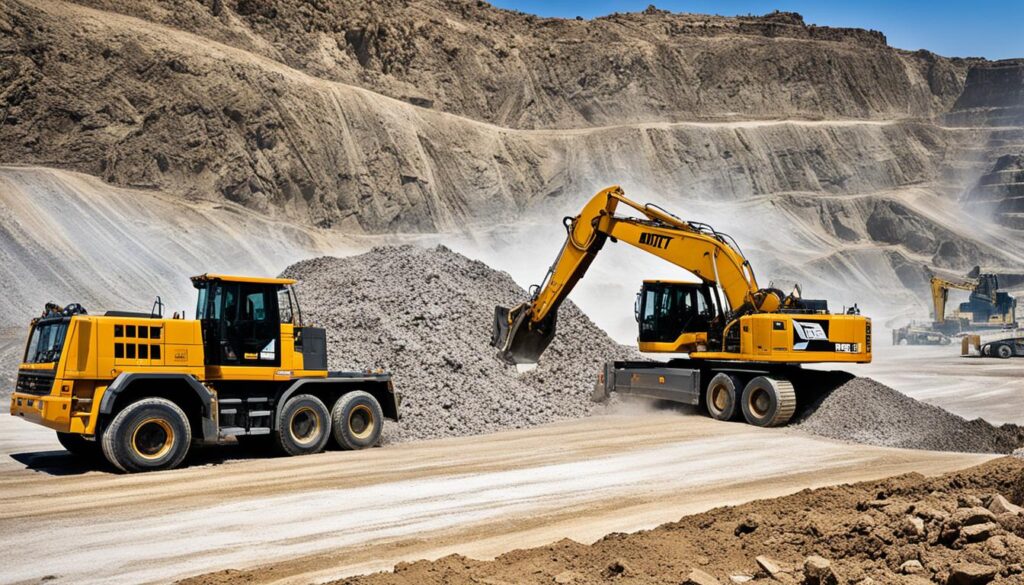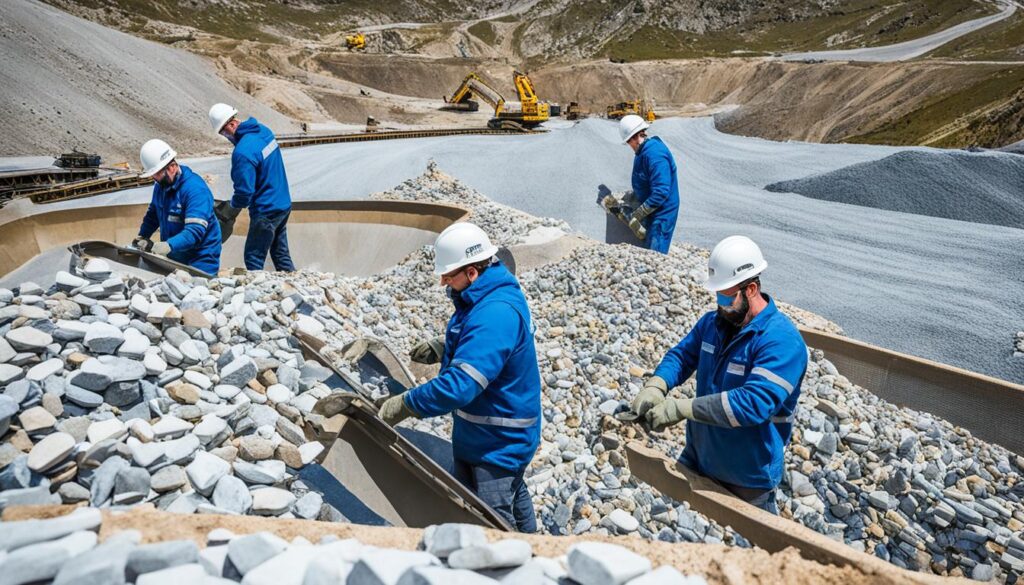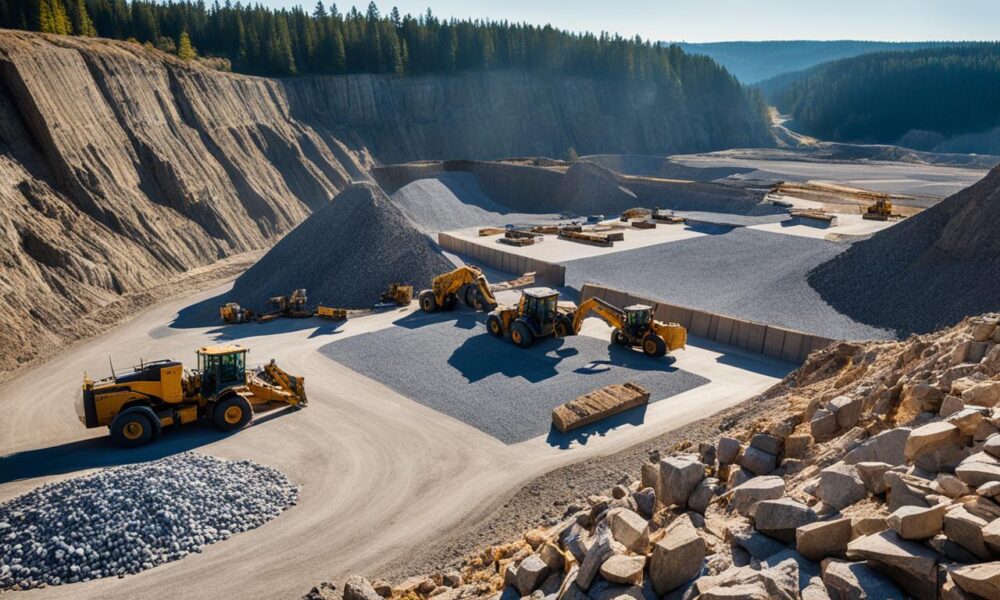Exploring Origins: Where Does Natural Stone Come From?
The quest for discovering stone origins leads enthusiasts and professionals alike into the heart of our planet’s geological artistry. The origin of stone materials often lies ensconced within the folds of metamorphic rocks, where the interplay of raw elements crafts the vibrant green emeralds the world adores. Natural emeralds encapsulate the essence of natural stone production areas, their lush hues and characteristic inclusions standing as proof of their storied birth.
In unraveling the origins of these captivating gemstones, one not only engages in a tale of beauty and rarity but also in understanding the profound impact these treasures have made upon human civilizations. The allure of natural stones, from the timeless elegance of emeralds to the architectural majesty of marble, creates a lineage of desire that traces back to the ancient world. Through dedication to sustainable methods, today’s stone enthusiasts continue to forge this legacy while preserving the earth’s integrity.
It is in these natural stone production areas that one can fully appreciate the sheer magnitude of nature’s creativity, a testament to the mystical and physical journey that these materials undertake from core to crown.
Key Takeaways
- Discovering the geological processes that form natural emeralds and other stones.
- Understanding the historical and cultural significance of natural stone production areas.
- Exploring the impact of natural stone from past to present.
- Highlighting the importance of ethical and sustainable extraction in the stone industry.
- Recognizing the global journey of natural stones, from quarry to final design.
The Birth of Beauty: Geology of Natural Stone Formation
The creation of natural stone is a testament to Earth’s geological prowess, a process brimming with intricacy and wonder. These geological marvels are not inherited by mere chance but are born from the dynamic processes that govern our planet’s interior. When seeking to understand where natural stone comes from, it is essential to delve into the formation processes that mold these treasures beneath our feet.
Formation Processes of Gemstones
The origin of gemstones is a chapter in the Earth’s biography that is written deep below the surface, in environments of immense heat and pressure. For example, diamond and zircon begin their journey in such depths, only to be propelled upward by forceful volcanic activity. Artifacts of their subterranean origin, these gemstones carry a history that is often illuminated through the features of each unique stone. In finding natural stone sources, geologists and gemologists alike decode the secrets locked within.
Distinctive Varieties and Their Origins
Not all stones share a uniform path to emergence. Some, like the vibrant topaz, the electric tourmaline, or the serene aquamarine, crystallize leisurely from the cooling concoctions of fluids and gases far beneath the terrain. Others form in pockets and fissures, with the iridescent Australian opal taking shape in the voids of rocks that became reservoirs for mineral-rich solutions. Yet, for garnet and jade, their essence is kindled through transformations powered by the Earth’s very movements, as heat and pressure forge new minerals from old. These diverse origination narratives, in tandem with unveiling stone extraction sites, highlight the myriad pathways of natural stone genesis.
The enchanting green beryl known as emerald is a prime case in point, its formation a dance of elemental chemistry involving beryllium mingling with trace amounts of chromium and vanadium. These elements coalesce in the Earth’s mantles, with the emerald’s vivid hue coming to life only under the most unique conditions. Each step in the remarkable sojourn from elemental birth to treasured jewel marks the sacred transformation that culminates in natural beauty.
A glimpse into these formation processes does not just answer the question of where natural stone comes from; it unravels a narrative of natural artistry and reminds us of our role in preserving these geological gifts. As we continue finding natural stone sources and unveiling stone extraction sites, it is paramount to honor the Earth’s historical generosity by advocating for ethical and sustainable mining practices, ensuring these natural wonders enthrall for millennia to come.
Discovering Stone Origins
In the quest to uncover the natural stone origins and stone extraction locations, the enthralling journey spans across continents, bringing to light the incredible geological narratives that have shaped the diversity of stones available today. From the ancient natural stone quarry locations such as the marble-rich landscape of Italy’s Carrara to the emerald bounties of the Colombian mines, the pursuit to discover where natural stone comes from immerses us in the very fabric of the Earth’s history.

The provenance of natural stone contributes significantly to its allure, a narrative woven into the geographic and geological strata of the earth. It is through a synergy of knowledge and experience in stone extraction locations that one can deeply appreciate the material that will eventually grace myriad design projects. In seeking the origins of natural stone, clients and designers are inspired by educational experiences, such as immersive visits to quarries where they can witness the extraction and meticulous selection process, thus gaining a profound understanding of the stone’s journey from earth to masterpiece.
- Carrara’s dedication to exquisite marble
- Sustainable practices in quarrying operations
- Educational programs enhancing stone appreciation
- Cultural significance tied to stone origins
Centuries-old techniques of quarrying merge with modern sustainability methods to ensure that the environments producing such treasures are preserved for future generations. The connective tissue between culture and natural stone origins strengthens as more environmentally conscious methods are adopted, showcasing an evolution in the relationship humans have with these ancient materials.
| Country | Stone Type | Notable Quarry | Unique Traits |
|---|---|---|---|
| Italy | Marble | Carrara | Lustrous White and Veined Textures |
| Brazil | Granite | Minas Gerais | Rich Color Spectrum and Durability |
| Egypt | Alabaster | Luxor | Translucency and Smooth Texture |
| India | Sandstone | Rajasthan | Warm Tones and Varied Patterns |
| United States | Slate | Vermont | Durable with a Range of Natural Colors |
| Colombia | Emerald | Muzo | Lush Green Color and Rare Inclusions |
The compilation of knowledge concerning natural stone quarry locations enriches not only the designer and client’s repository but also serves as a testament to the Earth’s splendid diversity. With every stone extracted and expertly crafted, the legacy of its origin plays an integral role in the narrative that stones carry through time, bridging the gap between natural wonders and human expression.
Finding Natural Stone Sources Around the World
The legacy of natural stone extraction sites spans centuries, encapsulating a history rich with artistry and geological significance. It’s a tale that unfolds across the globe, providing insight into the depths from which these stones emerge. As we consider where does natural stone come from, we embark on a journey that leads us to some of the most revered stone extraction locations revered for their quality and historical impact.
Historic Quarry Sites and Their Legacies
Historic quarry sites hold the echoes of past civilizations that once delved into the Earth to procure stones for their monuments and edifices. One such site is Carrara, Italy, a place synonymous with the finest marble—a material known for its pristine whiteness and dramatic veining, telling stories of antiquity through its use in sculptures and architecture. These legacies are preserved through the enduring popularity and demand for Carrara marble, which continues to be a hallmark of luxury and prestige in design.
Mining Techniques and Modern Advancements
The time-honored techniques of stone extraction have seen substantial evolution due to technological advancements in the industry. Modern methods of quarrying employ precision and efficiency, reducing environmental impact, and allowing for a more controlled excavation process. This modernization has transformed the way natural stones are sourced, ensuring their continued availability while respecting the landscapes that have harbored them for eons.
The intertwining of ancient knowledge with contemporary skill has allowed the stone industry to thrive in a global marketplace. This fusion ensures that as we continue to seek out various stone extraction locations, we do so with mindfulness towards sustaining the natural beauty and integrity of these natural stone extraction sites.
| Location | Stone Type | Notable Features | Extraction Technique |
|---|---|---|---|
| Carrara, Italy | Marble | Iconic White Hue with Grey Veining | Wire Saw Cutting |
| Rajasthan, India | Sandstone | Rich Textures and Earthy Colors | Channeling and Wedging |
| Muzo, Colombia | Emerald | Vivid Green Shades with Unique Inclusions | Tunneling and Blasting |
| Minas Gerais, Brazil | Granite | Diverse Colors and Grain Structures | Jet Piercing |
| Luxor, Egypt | Alabaster | Translucency and Fine Finishing | Hand Carving and Sculpting |
With every slab and stone unearthed, we gain a deeper connection to the Earth and appreciation for the human endeavor that brings its inner beauty to the surface. The journey that natural stone takes across the lands and into our homes is a testament to our unbroken bond with nature’s artistry.
Where Does Natural Stone Come From
Embarking on a narrative that stretches from the rugged terrains of quarries to the meticulous care of designer showrooms, natural stone narrates a tale of remarkable transformation. This chronicle entails not only its mining, cutting, and finishing but also the vital shift towards ethical and sustainable practices within the stone industry. The journey of stone is emblematic of the industry’s dedication to preserving the environment and fostering ethical trade.
The Journey from Quarry to Market
From the moment natural stone is quarried, its voyage reflects an intricate ballet of technology and tradition. This begins in natural stone production areas where the raw essence of stone is methodically extracted with precision. The process is a careful balancing act, attending equally to the integrity of the material and the safeguarding of the earth it’s drawn from. It is a dance of might and meticulousness as colossal blocks are cut from the land and then intricately shaped into slabs or architectural designs.

Once selected and extracted, these stone marvels undergo a meticulous process of crafting and polishing, transforming them into the luxurious finishes that grace homes, edifices, and monuments. The journey from quarry to market is a testament to the artistry and effort invested in each piece, ensuring the stone’s narrative continues from nature to civilization.
Sustainability and Ethical Stone Extraction
As the cornerstone of harmonious integration with our planet, sustainable stone extraction practices are more crucial than ever. Companies and consumers alike are pivoting towards sources that prioritize the environment, ensuring that the materials they use or sell come from operations that maintain ethical and sustainable practices in the stone industry. This involves a commitment to minimizing the environmental footprint of quarrying activities and preserving the ecological balance around production sites.
Furthermore, ethical sourcing is not limited to environmental stewardship but also encompasses the well-being of communities involved in the extraction and crafting of stone. From the bustling marble quarries in Italy to the serene alabaster digs in Egypt, each natural stone production area is embracing practices that ensure the safety, fair treatment, and ongoing prosperity of their workers, bringing a new era of responsibility in the stone trade.
In conclusion, as we adorn our spaces with the earth’s offerings, it remains our collective duty to support and participate in the sustainable and ethical journey of natural stone. The legacy of these practices ensures that the beauty we derive from natural stone is matched by a legacy of care and respect for the natural world and the people who nurture it.
Conclusion
In the culmination of our exploration into the roots of our planet’s geological offerings, we have journeyed deep into the heart of discovering stone origins. This odyssey has unearthed a greater recognition for the powerful forces crafting not only the striking emeralds but also other natural stone wonders like the storied marble of Italy. The legacy of natural stone, etched into the landscapes and exalted in our architecture, extends an invitation to designers and consumers alike to revel in the hidden narratives of their most cherished materials.
As we move forward, the natural stone industry is unveiling new heights in unveiling stone extraction sites and processes while holding steadfast to ethical and sustainable practices in the stone industry. This dedicated approach ensures not just the continuity of stone’s timeless beauty, but also the well-being of ecosystems and communities associated with its extraction and transformation. By prioritizing sustainability and ethical sourcing, we champion a future where the allure of natural stone can be cherished across generations.
Therefore, as patrons and professionals within the realm of design and architecture, our alliance with natural stone carries a significant responsibility. Embracing each slab, each sculpted piece, we are reminded of the fragility and magnificence of the Earth we share. It is a reminder that our choices have power—to support practices that honor the origins of our materials and to tread lightly upon the very ground that yields such treasures. Through this bond, we perpetuate a culture of admiration and respect for the planet’s geological masterpieces—past, present, and future.
FAQ
What processes contribute to the formation of natural stones?
Where are some of the most famous natural stone quarry locations in the world?
How do mining techniques affect the quality of natural stone?
Can the origin of a natural stone affect its quality?
How is sustainability being addressed in the natural stone industry?
Are there educational opportunities to learn more about natural stone sourcing?
Source Links
- https://www.linkedin.com/pulse/exploring-origins-formation-natural-emerald-stones-datahubtech-t5wnf?trk=article-ssr-frontend-pulse_more-articles_related-content-card
- https://worldstone.com.au/blog/exploring-the-origins-of-stone-a-worldstone-client-trip-in-carrara-italy/
- https://australian.museum/learn/minerals/gemstones/geological-origin-of-gemstones/



